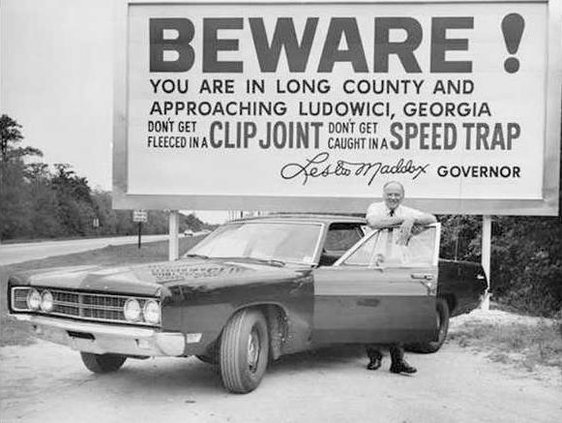Other stories in this special report:
SPECIAL REPORT: A speed trap's bad rap
Annexed areas make jurisdiction clearer, police say
Sheriff's deputies: Higher speeds mean more accidents
Ludowici, the county seat of Long County in Southeast Georgia, has a claim to fame that it would like to shed.
For years in the 1960s and the early part of the ’70s, Ludowici was the state’s most notorious speed trap.
Before then, it was known for a stop light that was manually switched to nab drivers on the popular route to Florida.
Gov. Lester Maddox, who served from 1967 to 1971, was so enraged by the practice that he erected billboards on the outskirts of town and posted a Georgia State trooper there to encourage drivers to slow down.
The story drew national attention, including an article in “Time” magazine. “The place is lousy, rotten, corrupt, nasty and no good,” Maddox told the magazine.
Today, the speed trap is long gone. The traffic, more than 1 million cars a year on U.S. highways 301, 25 and 82, is now far to the east on Interstate 95, which opened in 1974.
But the memory lingers.
“You can meet someone from Arkansas and say you’re from Ludowici and they remember it was a speed trap,” said Marky Waters, a bank executive who is president of the Long County Chamber of Commerce. “We’ve been trying to overcome that reputation for years.”
Waters said his community is now growing, primarily as a bedroom community to nearby Fort Stewart, which is undergoing a major expansion.
Closer to home, there have been numerous complaints about towns along U.S. 129 between Gainesville and Athens.
The towns of Pendergrass, Jefferson and Arcade have stepped up enforcement on the four-lane road. The highway is a major artery for football fans bound for Sanford Stadium at the University of Georgia.
The state has investigated and found nothing to substantiate the claims of being a speed trap.
The fines collected on the highway are a major source of revenue for the three towns, which in previous years have collected nearly $2 million combined.

